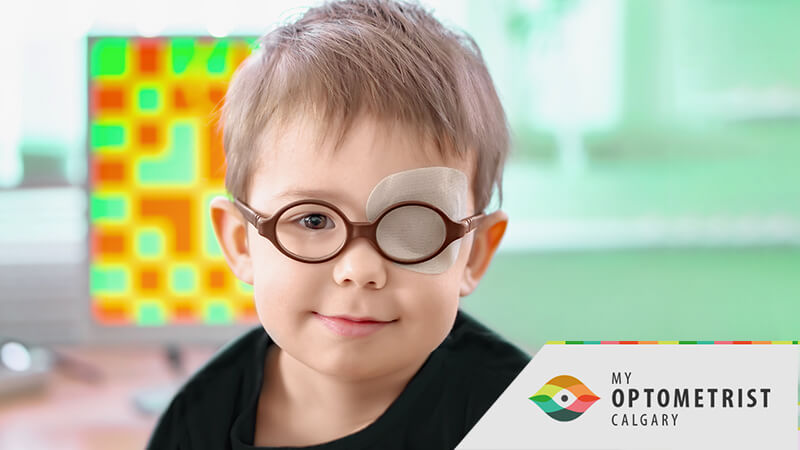
You might have heard of amblyopia by it’s more common name of lazy eye, but do you know why it develops or how it can be treated? Amblyopia occurs when the brain favors optical signals from one eye over the other, leaving one of the eyes to weaken and drift, becoming “lazy”. It is most commonly diagnosed in children and can often be treated with the use of an eye patch. If amblyopia is not treated, the weaker eye will continue to weaken and permanent vision impairment can occur.. Taking your child for their regularly scheduled eye exams is the best way to catch and treat amblyopia in its early stages.
Early Diagnosis Of Amblyopia Results In More Effective Treatment Outcomes
What Is Amblyopia? More commonly known as lazy eye, Amblyopia is a condition where the eyes do not align simultaneously, thus causing one or both of the eyes to wander, turning in, out, up, or down. The wandering (or lazy) eye is weaker and the vision in it will be impared. Amblyopia is most common in children and since the brain and eyes are still forging connections, correcting amblyopia is easiest while young.
What Causes Amblyopia? Here are two of the common reasons that amblyopia develops. If one eye has poor vision, or if the eye is not properly transmitting signals from the eye to the brain, the other eye becomes dominant and is relied upon. This causes the weaker eye to drift (become crossed)and the brain may not receive or it may ignore the signals being transmitted.signals it’s sending are not being transmitted or acknowledged by the brain. The reverse can also occur. An eye may have a natural misalignment or other physical issue that impedes vision, such as a drooping eyelid, which then causes the brain to primarily use the properly aligned eye.
How Is It Diagnosed? Crossed eyes or a drooping eyelid can be clear indicators of amblyopia, but sometimes these indicators are not present. Instead parents or teachers may notice the child is squinting, tilting their head, sitting closer to see better, or displaying clumsiness that could result from poor depth perception.
How Is It Treated? To treat amblyopia, the weaker eye needs to build up strength through use. This can be done through several methods:
- Glasses. When one eye is not in use because it can’t properly see, glasses can correct vision and give that eye an opportunity to see properly and start working.
- Eye Patches. A patch is worn over the stronger eye as a way to force the weaker one to work to keep up. The patch can be worn over the eye with an adhesive similar to a BAND-AID® or it can be worn over glasses by being secured to the lens in front of the strong eye. The patch is worn between 2 and 6 hours a day until the weaker eye builds up sufficient strength.
- Atropine Drops. These drops temporarily blur the vision and function in the same way as the patches. The atropine drops work well for those who don’t want to wear the eyepatch.
- Surgery. If the amblyopia is caused by an issue with the muscles that operate the eye instead of focus, eye muscle surgery may be needed. Surgery involves loosening or tightening the muscles causing the eye to wander. Surgery also might be done if amblyopia is caused by a droopy eyelid or a cataract. This type of surgery usually doesn’t require an overnight stay at the hospital.
Book Your Child’s Eye Exam Today
Amblyopia is most easily resolved when diagnosed and treated early. Sometimes the presentation of amblyopia is obvious, but sometimes the symptoms are not apparent. Regular eye exams for children allow your optometrist to recognize and diagnose amblyopia and begin treatment early with optimal outcomes. Book a comprehensive eye exam for your child with the experienced and professional staff at My Optometrist in Calgary by filling out the form below. Booking is easy and convenient with two locations in Calgary, at Sunridge in the NE and Sundance in the SE, and at our Three Hills AB location. Book online here. Let My Optometrist’s eye doctors help you and your child see clearly.
FAQ
Q: Does amblyopia affect vision?
A: Yes, left untreated amblyopia can result in declining or loss of vision in one eye.
Q: What are your chances of getting amblyopia?
A: This condition is very common in children, and symptoms may be difficult to distinguish from other visual conditions. At least 2-3 out of every 100 children are affected by this. It should be treated in early childhood, otherwise the condition persists into adulthood. If not treated early, the eyes may never achieve normal visual acuity, even with the assistance of contacts or prescribed glasses.
Q: When should I take my child to get an eye exam
A: It’s recommended to schedule your child’s eye exams at 6 months old, 3 and 5. After that, they should be getting exams annually.